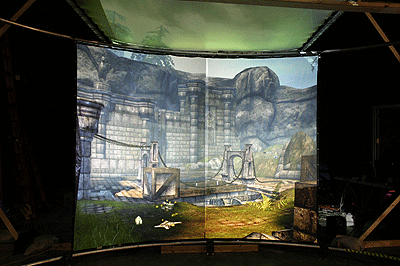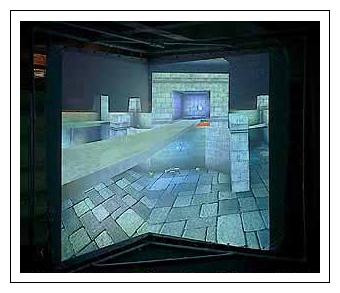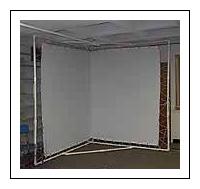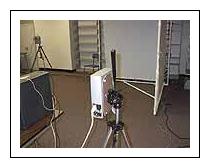Examples of CaveUT Implementations
CLARTE
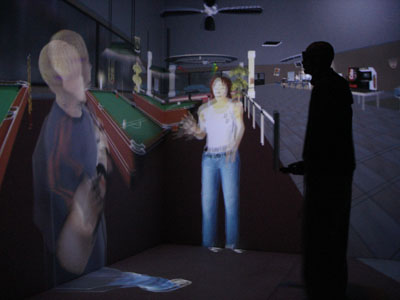
The ALTERNE Project is
an EU funded effort to create Virtual Reality tools for making art.
They built the SAS-Cube at CLARTE, a participating research
center in Laval, France, where they have installed CaveUT in their SAScube, a
fully equipped four-walled CAVE-like display. The primary contact for
ALTERNE is Dr. Marc
Cavazza at the University of Teeside in Britain. Their collaborators
have built an interesting collection of artistic projects using CaveUT.
They have extended CaveUT to support stereographic display and
real-time spatial tracking. The programmers for this effort are
Marc Le Renard and Jean-Luc Lugrin. We expect to make these capabilities
available to CaveUT users sometime in the fall. The image on the
right shows the user interacting with autonomous agents in a virtual
pool hall.
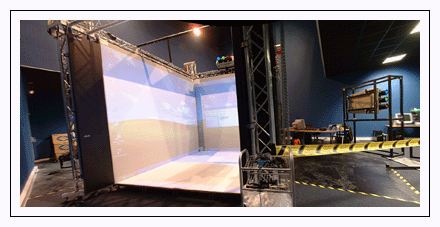
|
The Virtual Theatre
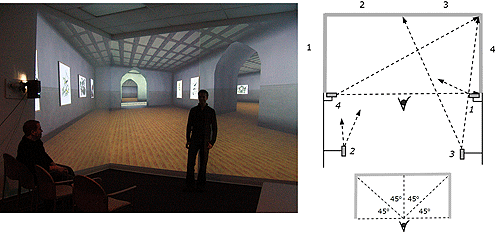
The School of Information Sciences at the University of Pittsburgh,
in cooperation with the VISIC Lab (see below) set aside a room and
bought the equipment for a CaveUT Based immersive environment. It is
intended for general use in the school for student and faculty
research projects. It has four projectors, two projecting onto the
back wall of the room and two more projecting onto the
sides. Essentially it is two two-walled caves stuck together. This
image shows a student, Lyle Seethaller standing in front of his
Virtual Audubon Exhibit. which he built using the authoring tools that
come with Unreal Tournament. CaveUT can display any virtual
environment built for Unreal Tournament, without modification.
|
The Flatworld Project
BNAVE
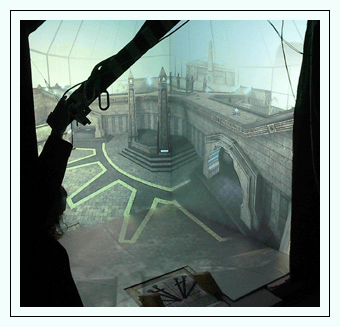
CaveUT was originally developed on the BNAVE, a PC-based CAVE-like display the Medical Virtual Reality Center, Department of Otolaryngology, University of Pittsburgh.
To the right is a picture of the BNAVE showing DM-Suntemple, a
virtual world that comes prepackaged with UT. The screens are at an
80.5-degree angle to each other, and we are looking straight into the
corner. (The image looks bent because the camera taking this picture
could not be placed in the ideal viewing location; the image does not
appear bent to someone standing in the correct position before the
screens.)
The BNAVE consists of three walls arraigned in a "U" around the
viewer. A fourth projection surface has been added to the floor.
Each wall is a rear-projection screen. Onto each of the three
screens is rear-projected projected the SVGA output of a dedicated PC.
|
Mini Cave at VISIC Lab
These three images show CaveUT in the
"Mini Cave" at the VISIC Lab
at the University of Pittsburgh. The mini-cave is a three-screen affair
small enough that all the computers required to run will it fit on a
desktop. Its basic design is much like the BNAVE or any other generic
PC-based cave. The first image shows a virtual world called
DM-Antauls.
The second shows a virtual world called DM-Serpentine.
The last shows the physical setup of the computers running the
mini-cave.
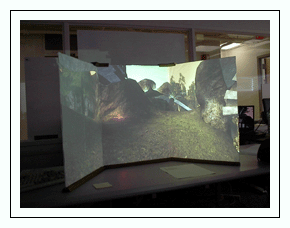 |
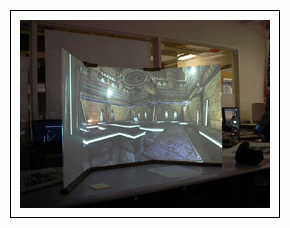 |
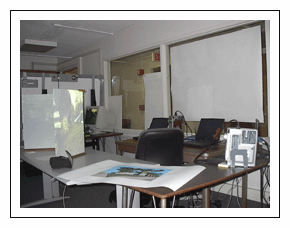 |
| DM-Antauls |
DM-Serpentine |
Physical Setup |
The VISC Lab also built a complete V-Cave (see below) for more immersive applications.
The Portable V-Cave
Earth Theater
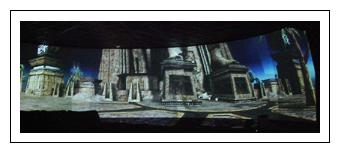
The Earth Theater (left) at the Carnegie Museum of Natural
History has a CaveUT installation. The theater has a fully digital
display composed of five curved front-projected screens spanning 210
degrees horizontal and 30 degrees vertical. Five standard video
projectors, each driven by a PC running windows, produce the Unreal
Tournament display. As you would expect, each of the five projector PCs
is running a spectator, which provides the appropriate view from a
single player on a sixth PC.
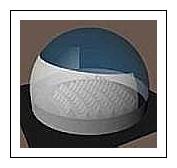
Interestingly, the careful design of the theater makes off-axis
projection unnecessary. However, the curved screens require a spherical
correction of the image, otherwise we get those wedge-shaped overlaps
you can see in the image if you look closely. Willem de Jonge are just
now working on a spherical correction to the OpenGL code.
On the right is a Schematic of the Earth Theater. The screen is a
section of a sphere, 210 degrees horizontal by 30 deg vertical. In the
figure, the screen is depicted in a transparent white in front of the
seats.
Last updated 20 May 2005.
URL: http://www.planetjeff.net/ut/CaveUT.html
This page is copyright © 2004 by Jeffrey Jacobson.
See this web site's copyright notice for information
on duplicating or distributing this page or its contents.
|
|



